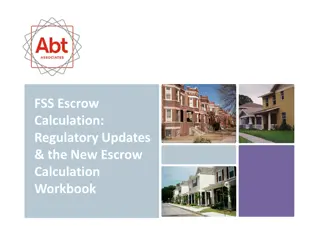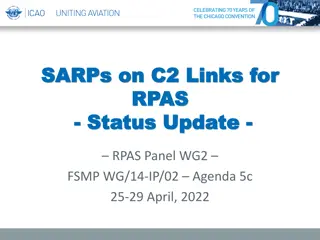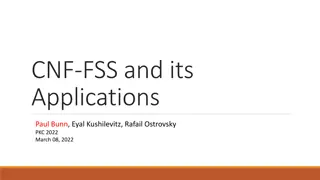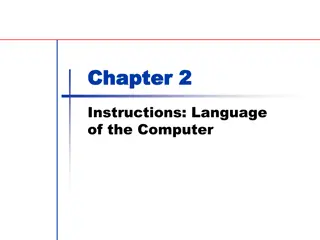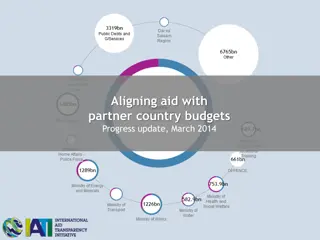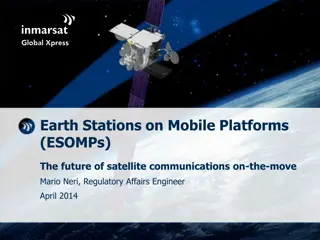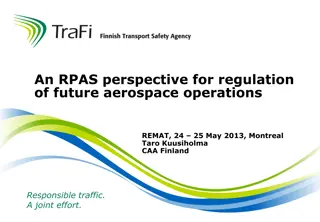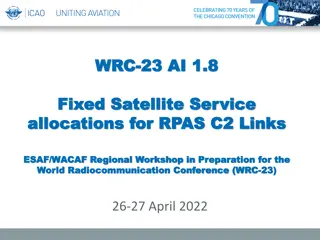Understanding the Importance of FSS Link Budgets for RPAS Operations
FSS link budgets play a crucial role in ensuring the required performance of C2 links for RPAS operations. They help confirm achievable link performance, define minimum performance values, establish operational and technical boundary conditions, and assess RLP conformity in satellite networks. By determining the Required and Achieved Link Performance, these budgets ensure safe and efficient RPAS operations within designated airspace.
Download Presentation

Please find below an Image/Link to download the presentation.
The content on the website is provided AS IS for your information and personal use only. It may not be sold, licensed, or shared on other websites without obtaining consent from the author. Download presentation by click this link. If you encounter any issues during the download, it is possible that the publisher has removed the file from their server.
E N D
Presentation Transcript
Ku and Ka Band FSS Ku and Ka Band FSS Characteristics and Link Characteristics and Link Budgets for support of Budgets for support of RPAS RPAS FSMP WG/10 IP-02
Content Philosophy Why we need link budgets FSS C2 Link budgets Required Link Performance Operational / safety requirements Basis for SARPs / specifications FSS based C2 Link: Data rate independent link budget formula vs. Achieved Link Performance Satellite link overview General key parameters and their sources Input parameter variations C2 Link Parameter Inputs Compliance checks of input parameters Link budget calculations (clear sky conditions, time invariant losses) Derivation of driving link parameters Link Performance Analysis (Part 1) Parameter dependent feasibilities for full C2 Link connections Statistical evaluation of the large number of link budget results Next Steps: sensitivity analyses of the results Link Performance Results (Part 1) 2
Why do we need FSS Link Budgets? Link budget analysis needs to confirm that the Required Link Performance can be Achieved Need to define the minimum performance values of the C2 Link characteristics in the SARPs Need to define any operational boundary conditions in the SARPs Need to define any technical boundary conditions in the SARPs This should be carried out for nominal solutions but considering potential mitigations 3
Why do we need FSS Link Budgets? Will the Fixed Satellite Service enable the C2 Link to Achieve the Required RLP? C2 Links using the FSS shall operate within the notified and recorded parameters of the satellite networks in accordance with Resolution 155 (Rev.WRC-19) Will the limitations imposed by FSS networks (transmitter power etc.) enable the C2 Link RLP to be achieved? Will C2 Link interruptions due to operational effects (e.g. weather, and/or potential coexistence or interference issues) allow the Required C2 Link RLP to be Achieved? Can the satellite based C2 Link operate successfully under the conditions stipulated in Resolution 155 (Rev.WRC-19)? RLP conforming satellite links not causing more interference than coordinated/notified incumbent FSS applications RLP conforming satellite links not requiring more protection than coordinated/notified incumbent FSS applications 4
How do we determine the Required and Achieved Link Performance? The Required C2 Link Performance (RLP) is based on safety considerations RTCA and EUROCAE are working on this topic Performance depends on class of airspace, phase of flight and pilot activities The Achieved C2 Link Performance is based on technical and operational considerations ICAO needs to make this analysis for the Ku and Ka Band FSS by developing link budgets If the Achieved C2 Link Performance meets or exceeds the Required C2 Link performance, then the C2 Link can be used to provide adequately safe RPAS operation 5
How do we determine the Achieved Link Performance? Describe the C2 Link technical solution in sufficient detail to enable representative link budget analysis to show that meeting the RLP is possible under defined conditions Each RPAS Operator/C2SP will have to show they comply with specific safety requirements imposed by their Aviation Authority Mitigation measurements according to the Lost C2 Link procedure are to be considered/included for cases when the RLP and Lost C2 Link Decision Time is not met in order to control the situation to an adequate level of safety Include the minimum performance values of the C2 Link system parameters Include any operational limitations and/or mitigations High level in the SARPs with supporting detail in the Manual on the C2 Link 6
FSS Link Budgets for Achieved Link Performance Main Principle What information is needed to perform link budget analysis? Basic link budget equation Data rate independent ES/N0 dB = EIRPSD dB - Path Loss dB + G/T dB + 228.6 dB* * 228.6 (log of Boltzmann Constant) converts T (in G/T) to noise power in 1Hz ES/N0 = Received Energy per Symbol compared to Noise Power in 1Hz Signal entering the receiver demodulator (Eb/N0 comes out of the demodulator) EIRPSD = Transmitted Radiated Power (EIRP) in 1Hz (SD, Spectral Density) Using ES/N0 and EIRPSD means analysis is independent of data/symbol rate Path Loss: Part 1): for clear-sky , Path Loss includes time-invariant effects like free-space loss, polarization losses, intermodulation impairments, fixed interference (FSS + terrestrial in general), satellite tolerances. Part 2): additional atmospheric attenuation and time-variant interference will be included in the Path Loss to determine the ES/N0 and link availability for determining if the RLP can be met. 7
FSS Link Budgets Link Definitions Edge of Coverage - EoC Center of Beam Link 1 and 2 provide the Forward Link (i.e. telecommands) Link 3 and 4 provide the Return Link (i.e. telemetry) 8
FSS Link Budgets General Link Related Limits Off-Axis EIRPSD into adjacent satellites two or more degrees away from satellite being used Uplinks 1 and 3 must meet the Off-Axis EIRP SD limits set by ITU-R ITU-R Article 22.26 and ITU-R Recommendation S.728 (Ku band); * Link 3 may also have PFD limitations for certain frequencies and in certain regions Annex 2 to Resolution 155 ITU-R Article 22.32 and ITU-R Recommendation S.524 (Ka band) Downlinks 2 and 4 must meet the PFD limits set by ITU-R ITU-R Article 21.16 for Ku Band No ITU-R limit in Ka Band so using coordination levels from the FCC 9
FSS Link Budgets System Characteristics 1/2 All satellite networks must go through a process of notification, assessment, coordination and recording with the ITU-R before they can be used This process allows ITU-R, administrations and satellite operators to make sure that these networks will not cause harmful interference to recorded users of the same allocations or receive harmful interference from those recorded users This recorded information is held within the ITU-R Master International Frequency Register (MIFR), which is an MS Access relational database updated and published every two weeks by the Radiocommunications Bureau (BR) 10
FSS Link Budgets System Characteristics 2/2 To assist ITU-R and ICAO in their work related to Resolution 155 ITU-R has been using the MIFR to assess the envelope of characteristics of the FSS satellite networks that comply with Resolution 155 and to provide statistical information on the values of the parameters of those characteristics ITU-R can then check that the proposed RPAS C2 Link characteristics parameter values are inside the envelope of these notified and recorded parameter values ICAO can then use those characteristics parameter values in their link budget analysis to check for adequately safe operation ITU-R WP5B/712 Annex 5 liaised to ICAO in FSMP WG/08 WP02 > RPASP/13 WP/5 11
How do we use the MIFR Data? The filed FSS satellite networks according to the ITU-R MIFR cover a wide range (within their authorized envelope of operation) of characteristics parameter value variations Often beyond typical system realizations and providing a large envelope of characteristics parameter values Hence, a set of characteristics parameter values with a certain minimum or maximum performance inside the filing envelope needs to be derived Assessing each of the thousands of satellite network filings is not effective and would not lead to: Maximizing the Achieved performance to provide a highly reliable link for safety of life applications fulfilling the RLP Maximizing the ability of the RPA to operate in different combinations of flight altitudes and latitudes, for different elevations (larger than a minimum recommended one) A comprehensive set of values (performance thresholds) for each of the characteristics in the SARPs not just a go/no go for each satellite network with no indication of the suitability of future satellite networks or the parameter values that were necessary to meet the RLP 12
FSS Link Budgets Key Link Parameters MIFR: Parameters used in the link budget equation: Antenna gains Power / power density per reference bandwidth (satellite and Earth station) Noise temperature MIFR: Derived parameters used in the link budget equation: EIRP / EIRPSD (from power and signal bandwidths in MIFR) G/T (from antenna gain and receive noise temperature in MIFR) Saturated Flux Densities Limits used in the link budget equations: Recommendations ITU-R S.524, S.728: Off-axis EIRPSD for uplink from AES and GES in Ka band and Ku band, respectively ITU-RR, Appendix 7: Antenna gain pattern for AES antenna (plus Capped Bessel model) and GES antenna Recommendations ITU-R S.1432: Interference caused noise increase for both, uplink and downlink ITU-RR Article 21.16: Satellite downlink PFD limits in Ku band 13
FSS Link Budgets - Link Parameter Values RPASP WGWHL/1 WG2 WP/5 contains the specific parameter values used (see back up slides 24-26) RPASP WGWHL/1 WG2 WP/5 explains how they were derived from the ITU-R MIFR data (see back up slides 24-26) Six sets of characteristics parameter values were chosen from within the ITU-R MIFR envelope Satellite, Low and High Gain RPS, Medium and Large Antenna RPA, Small and Medium (each with two patterns) Antenna They maximized the link margin available to counteract rain and time varying interference They ensured many of the satellite networks in the ITU-R MIFR could be used for RPAS 14
FSS Link Budgets Summary of Link Parameter Variations Operational Inputs Satellite Operations Parameters Example b) Res. 155 (Rev.WRC-19) 15
FSS Link Budgets Calculation Flow And Main Steps See previous slides summarizing all input parameter variations (1920) Ku band: 1440 input variations 720 C2 Link connections with forward link and return link, each Ka band: 480 input variations 240 C2 Link connections with forward link and return link, each Input selection Note 1. Data rates are derived from RTCA DO-377 MASPS for C2 Link Systems Note 2. Waveform/MODCOD chosen for good operation at low Es/No to maximize link margin Max. data rates rB = 30 kbps (FW), 300 kbps (RT) Note1 MODCOD = BPSK-1/3, Roll-off-factor roff= 15% Note 2 Signal bandwidth = rB* (1Hz/bit / (1/3)) * (1 + roff) = 103.5 kHz (FW), 1035 kHz (RT) Note 3 Waveform Note 3. Using the formula in slide 9 avoids the need for data rates and bandwidths, but all the compliance checks against limits (per reference bandwidth) require to apply such inputs Ku band: Uplink EIRP against off-axis PFD limits mask a) and b) from Example 2 Res 155 (Rev.WRC-19) Ku band: Uplink EIRP against off-axis EIRP limits from Recommendation ITU-R S.728 Ka band: Uplink EIRP against off-axis EIRP limits from Recommendation ITU-R S.524 All: Uplink EIRP against system internal limits (terminal performance, satellite SFD limit) All: Uplink EIRP against downlink PFD limit (Ku band) or downlink coordination limit (Ku / Ka band) via the uplink-downlink transmission gain based on the satellite gain Uplink (link 1 and 3) limit checks 16
FSS Link Budgets Calculation Flow And Main Steps Ku band uplink EIRP: Minimum from uplink PFD mask or S.728 EIRP, from EIRP limit for needed input backoff (IBO) versus saturation, from terminal EIRP (capability) limit and finally from satellite downlink PFD limit reversely transferred to the uplink via the satellite gain Ka band uplink EIRP: Minimum from S.524 EIRP, from EIRP limit for needed input backoff (IBO) versus saturation, from terminal EIRP (capability) limit and finally from satellite downlink EIRPSD limit reversely transferred to the uplink via the satellite gain Start uplink calculations Earth station EIRP tolerance / pointing loss / radome loss (dB): Ku band: 0.5 dB up to 1 dB depending on the version of the AES or GES Ka band: 0.5 dB up to 2 dB depending on the version of the AES or GES Free Space loss for different AES distances (elevation dependent) and for GES distance fixed @ 10 elevation (worst case) Polarization loss of co-polarized signal = 0.5 dB plus cross polarization interference (XPD = 25 dB) Satellite receive gain versus center of beam: -5 dB Time invariant interference: T/T = 32% from S.1432-1 Uplink losses, impairments Calculation of input power flux density (IPFD) and IBO IBO setting based on intermodulation and gain compression requirements Satellite gain tolerance: 0.75 dB Total satellite gain for downlink EIRP Satellite payload gain 17
FSS Link Budgets Calculation Flow And Main Steps Satellite transmit gain versus center of beam: -5 dB Free Space loss for different AES distances (elevation dependent) and for GES distance fixed @ 10 elevation (worst case) Cross polarization interference (XPD = 25 dB) Time invariant interference: T/T = 32% from S.1432-1 Earth station EIRP tolerance/ pointing loss / radome loss (dB): Ku band: 0.3 dB up to 2.4 dB depending on the version of the AES or GES Ka band: 0.1 dB up to 2 dB depending on the version of the AES or GES Downlink (link 2 and 4) losses, impairments Achieved ES/N0total based on combination of: ES/(N+I)0uplink ES/N+I)0downlink ES/N0intermodulation ES/N0polarization Required ES/N0 required> 0 dB (including 1 dB system margin) ES/N0 aggregations Success will be achieved when the complete C2 Link connection comprising the forward link (link 1 and 2) AND the return link (link 3 and 4) both provide positive link margins of the ES/N0 total compared to the ES/N0 required Determining the driving link budget elements: First limiting parameter for uplink EIRP: PFD mask / terminal capability / satellite IBO / downlink PFD Highest share of transponder resource: power driven versus bandwidth driven Smallest ES/N0margin for: uplink / downlink / intermodulation C2 Link performance 18
FSS C2 Link Budgets Results Success criteria: Positive link margins for forward link (link 1 and 2) AND return link (link 3 and 4) For C2 Link adapted transponder gain setting AES antenna pattern per AP7 Fulfillment rate for No. of feasible links Ku band low gain satellite 58.3% Ku band high gain satellite 73.9% Ka band low gain satellite 100.0% Ka band high gain satellite 100.0% AES antenna pattern per Capped Bessel Fulfillment rate for 69.4% 81.7% 100.0% 100.0% No. of feasible links 125 (from 180) 147 (from 180) 60 (from 60) 60 (from 60) 105 (from 180) 133 (from 180) 60 (from 60) 60 (from 60) Statistics of successful link budgets AES antenna pattern per AP7 Minimum E2E link margin link margin AES antenna pattern per Capped Bessel Minimum E2E link margin link margin Average E2E Maximum E2E link margin Average E2E Maximum E2E link margin Ku band low gain satellite Ku band high gain satellite Ka band low gain satellite Ka band high gain satellite 0.1 dB 11.7 dB 15.5 dB 0.1 dB 11.6 dB 15.5 dB 0.1 dB 12.2 dB 16.3 dB 0.2 dB 12.4 dB 16.3 dB 3.7 dB 9.8 dB 13.3 dB 2.0 dB 9.6 dB 13.3 dB 11.6 dB 12.9 dB 14.5 dB 10.0 dB 12.5 dB 14.5 dB 19
FSS C2 Link Budgets Conclusions on Performance defining Key Link Parameters Highest criticality from the combination of small AES antenna size and off-axis transmit limitations On-Axis EIRPSD limited because of the off-axis EIRPSD limit due to the limited antenna angular gain discrimination; Gain and G/T of small sized AES antennas in the lower half of the parameter envelope of typical FSS Earth stations in the MIFR; To compensate a robust BPSK 1/3 waveform was chosen, but its less bandwidth efficient no significant effect as the date rates are very small from the FSS point of view; Out of all individual link budgets in 56.3% cases, the ES /(N+I)0 total is driven by the ES /(N+I)0 uplink, the rest from the ES /(N+I)0 downlink (see slide 21) Typical RPA antenna sizes 0.8m (medium) and 1.2m (large) with ITU-R AP7 or Capped Bessel pattern and 55% efficiency covering planar antennas as well as dish-based antennas with 65% efficiency Capped Bessel pattern did not give as much improvement as expected because off-axis pattern was not optimized over the required range of angles to minimize off-axis gain and maximize on-axis gain * 20
FSS C2 Link Budgets Conclusions on Results Dependencies When considering all C2 Link calculations (Part 1) Inside the FSS link conditions the uplink (off-axis limitations) are more driving than the downlink.; Impacts from satellite settings (IBO, gain settings) are small capability for using backup satellites (nominal gain settings in table) without specific (Adapted) settings. Results on C2 Link connectivity basis End-to-End link budget results (AP 7 pattern) Adapted Gain Setting Nominal Gain Setting 960 C2 Link connections (FL + RL) 960 C2 Link connections (FL + RL) U/L mask (Link 1, Link 3) U/L SGT power capability (Link 3) Satellite IBO D/L Limit (from Link 2, Link 4 reversely transferred to Link 1 and Link 3) Power 342 35.6% 414 43.1% 0 0.0% 0 0.0% First limiting parameter for uplink EIRP (Link 1 and Link 3) 120 12.5% 120 12.5% 498 51.9% 426 44.4% Highest share of transponder resource, power vs. bandwidth (all links) 426 44.4% 390 40.6% Bandwidth 534 55.6% 570 59.4% Uplink ES/N0 Intermodulation ES/N0 Downlink ES/N0 540 56.3% 480 50.0% Smallest ES/N0 margin for 0 0.0% 0 0.0% 420 43.8% 480 50.0% 21
FSS C2 Link Budgets Next Steps Part 1 Clear Sky link analysis Initial link analysis completed Validation of link analysis is now underway Part 2 Time varying rain and interference analysis Some of the links from Part 1 will not have enough clear sky link margin to compensate for the effects of time varying interference and rain so that the RLP can be achieved Interruptions will be longer or more frequent than acceptable for safety Analyze Part 1 and Part 2 to determine the characteristic parameter minimum values for the SARPs Relationship between results and key parameter variations based on a statistical evaluation to derive the parameter value limits Include any operational and technical mitigations in the SARPs 22
Satellite Parameter Values Based on MIFR data which gives the center of beam peak gains 24
AES Parameter Values Based on the 10 - 50 percentile values because the RPA antenna is small 26






